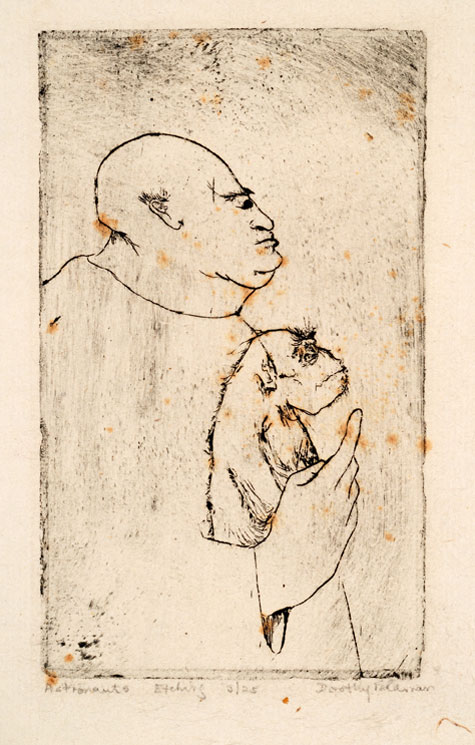
AN EARLY BEGINNING "Astronauts," etching, 1958, by Dorothy Schwartz |
This year marks the bicentennial of the birth of Charles Darwin, as well as the 150th anniversary of the publication of his
On the Origin of Species, a felicitous time for an exhibit manifesting a lifelong personal interest in Darwin and his observations. This month, Dorothy Schwartz crowds the June Fitzpatrick Gallery at the Maine College of Art with 46 monotypes, prints, and drawings reflective of the artist's fascination with the evolution of Darwin himself; both in the progress of his theories as he developed them and as they've succeeded him, and in the personal life and practice which shaped his work.
Schwartz writes in her artist statement that she "set out to embody (Darwin's) ideas symbolically in a new series of prints and drawings." She does this blatantly in "I Think..." her lithograph reproduction of the first evolutionary tree sketched in Darwin's notes, and with quick expressive monotypes of the obvious finches, a tortoise, and a rhea. Alongside are portraits of Darwin, his wife and cousin Emma, and daughter Annie; we wonder why the show is titled "From So Simple A Beginning: My Darwin." A subjective relationship to the subject matter seems absent in this work; the portraits appear to have been studied from iconic photographs of the family.
Both aesthetically and conceptually, the ballasts of this exhibit are two moody monotypes depicting Darwin's silhouette walking on a shadowy wooded path. The figure is barely discernable from his setting, both handled with an expressive, almost violent hand. Schwartz studied with Leonard Baskin at Smith College, and his influence is seen here in the saturnine landscape and stark contrast.
In these prints, Darwin is presumably walking the Sandwalk, a thinking path he would circumambulate every day regardless of the weather. This path seems to be of particular interest to Schwartz and her husband, composer Elliott Schwartz, whose eerie composition Soundwork for the Sand Walk complements the artist's work in the gallery. The pair spent three months in Cambridge, England, where the composer was a visiting fellow at Cambridge University (which Darwin attended), and spent time researching in Darwin's house, laboratory, and garden in Kent.
The attention to the Sandwalk provides the questions lacking elsewhere in the show, provoking consideration of Darwin's process, routine, and the environment that nurtured his exploration and writingElliott Schwartz's sound piece is inspired by the Broadwood piano that Emma Darwin would play for Charles each evening at the Down House; it loops and layers performances from Schwartz's past, including a piece by Schumann that was also potentially played by Mrs. Darwin, and recordings from a machine used during a cataract surgery the composer underwent. These layers build and deconstruct, compete with one another and then find harmony, not unlike the process of evolution, and what may have been accompanying Darwin's thoughts as he strolled the thinking path.
Showing her own progress, three curious etchings from 1958 are among Dorothy Schwartz's recent work, otherwise completed in 2008 or 2009. These prints evince her early interest in Darwin, with studies of spiders, talons, and human proportions etched in a confident line reminiscent of the 19th-century naturalist drawings Darwin himself would have studied. "Astronauts" depicts a modern cloaked Homo habilis-esque man carrying a chimp like one would a small child. Both are shown in profile, highlighting their mirrored craniums, staring stoically into the distance. The man holds his right hand up, pointing to the chimp with a "Creation of Adam" grace that seems to gesture toward the future of our genus.
Hurtling into the present day, Schwartz fills almost half the gallery with her contemporary spin on penschilderij, a 17th-century Dutch pen-painting technique. Though it is unclear why this particular method was appropriated for the subject matter, metallic silver, blue, and gold line drawings on black-primed canvases convey microscopic views of cellular forms and processes. The largest of these hangs in the Congress Street window, and is one in a series of representations of H1N1, the swine-flu virus. These bold canvases may clash with the more delicate monotypes and etchings, and read like a second show altogether, but as the virus is unstable and capable of exchanging genetic material to form new strains, conceptually they display a contemporary concentrated evolution in action.
Annie Larmon can be reached at aglarmon@gmail.com.
"FROM SO SIMPLE A BEGINNING: MY DARWIN"drawings & prints by Dorothy Schwartz + soundwork composed by Elliott Schwartz | at June Fitzpatrick Gallery at MECA, 522 Congress St, Portland | Through June 26 | 207.879.5742